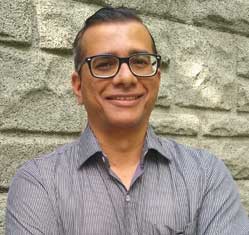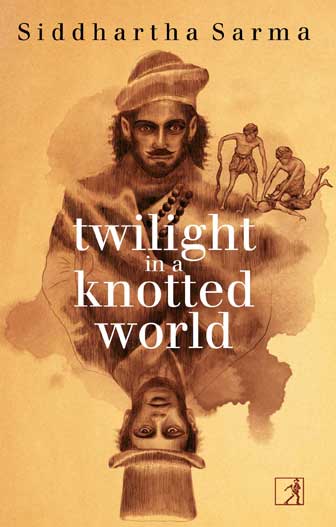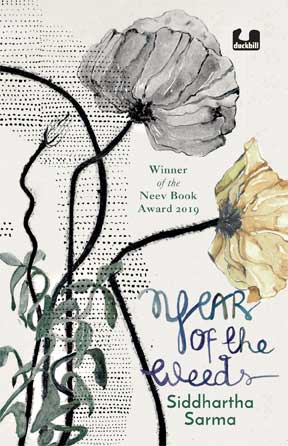Chintan Girish Modi
Have you considered teaching history using historical fiction? This might sound like an odd idea at first but it is worth exploring, especially for the sake of students who find history boring or irrelevant. It might also be an opportunity to enrich your own relationship with the subject.

Siddhartha Sarma is a historian, journalist and writer of fiction. He studied military history and battlefield archeology for an M Litt in War Studies at the University of Glasgow, where he specialized in medieval warfare and wrote a thesis on the later Crusades. He is currently guest faculty for History at the University of Delhi.
His latest book, called Twilight in a Knotted World, was published by Simon & Schuster India in 2020. In this interview, he talks about the curious blend of history and fiction that animates his work and the rigorous research it requires. He also dwells on how history is used for political ends, and what writers can do while writing about marginalized communities.

How does your academic training as a historian support or meddle with your craft as a novelist?
Historical fiction, if written well, makes periods and personalities come to life. The idea is to enable a more intimate engagement with certain parts of the historical record. This process of giving a sense of vitality to names and events is what interests me the most about this genre.
My training as a historian helps me conduct research for my fiction projects. It enables me to engage objectively with the historical record and parse texts. These form what may be called the background tapestry of a historical fiction story. I try to keep the plot, timeline and characters as close to actual history as possible, so my background as a historian supports my craft quite well in this.
Of course, there are limitations and constraints in this process. For instance, I have tried to keep the speech patterns in Twilight in a Knotted World as close to what they were among the respective classes of people in India in the 1820s and ‘30s. One has to be very careful while doing this because anachronisms have a way of creeping into a fictional work. This process is more of an interesting exercise than a hindrance to writing a story.

Year of the Weeds is set against the backdrop of the Niyamgiri agitation in Odisha in the 2000s, and The Grasshopper’s Run is set during the Japanese imperial army’s invasion of British India in 1944. Both these books were written for young adults. How did you strike a balance between holding their interest and not talking down to them?
I guess both – holding their interest and not talking down to them – are connected. In both stories, I tried to introduce the respective regions and people and context. In many ways I was trying to understand these myself – conflict and the Nagas in the 1940s in the case of The Grasshopper’s Run, and the nexus between the government and corporate entities in the case of Year of the Weeds. Some of that process of discovery crept into the stories, so they were introductions for both the reader and me. It was a shared journey. Young adults are the same as any other version of adults, only their minds are sharper and they are most honest in their perceptions. As a type of readership, a writer could not ask for a better group.
When you were writing about Nagas in The Grasshopper’s Run and Gonds in Year of the Weeds, how did you approach the question of representation? Knowing that readers in many parts of India have little contact with the Northeast, and a limited understanding of the indigenous communities that live there, did you feel responsible for writing in a way that would counter ignorance and prejudice?
The main idea was indeed to write these stories to promote understanding and counter misinformation, possibly even prejudice. The plot and characters were intended to ease the reader into the worlds of these stories. It helps to have some characters who work as intermediaries into complex, relatively less-known cultures. In the case of The Grasshopper’s Run, it is Gojen, who is not a Naga. In the case of Year of the Weeds, it is Anchita, who is not a Gond. Through them, we as outsiders see these societies and these people and their intimate lived experiences.
It is a very thin line that one must tread with care. While working on the story, one must be careful in how one chooses to represent the people one writes about. While I believe that a writer is free to write about any people she chooses, in the case of such complex issues and histories, one must remember that these stories ultimately belong to the people from whom they emerge. The writer only borrows these stories for a while, and must respect the original owners.
Twilight in a Knotted World is woven around historical personalities who rarely make it to school textbooks in India – Captain William Henry Sleeman, Brian Houghton Hodgson, James Prinsep, Sir Arthur Thomas Cotton, Qudsia Begum, Amélie Josephine, Syed Ameer Ali, Kashi Naresh Udit Narayan Singh, and a number of others. What pulled you into their universe?
The fact that these personalities of the pre-1857 period do not really occur either in our imagination or textbooks is a symptom of the problems in Indian historiography, specifically the odd jumps from one period to another without an adequate understanding of the complex events and people in the intervening years. Indian history was a millimetric progression of fascinating complexity.
I began writing the novel mainly about Sleeman and Phansigars. In the process, these other interesting characters just had to shoulder their way in. Partly as a way of bringing vitality to the narrative and partly because they are significant in terms of their place in history, their rich inner lives and their actions. They just had to be there, and I tried to make them as accessible to the reader as I could while recognizing that, because of their absence from textbooks as you mention, they might be a bit obscure. I had to introduce and bring them to life as well as I could.
How would you describe the Phansigars to someone who is hearing of them for the first time? Referring to them merely as criminals seems inadequate because there is a social history associated with the choices they make yet there is no denying the fact that they are responsible for dumping bodies in mass graves. What kind of ethical questions did you grapple with while writing about them?
Several generations of people in the hinterland were driven by poverty and post-Mughal political strife to become a specific kind of robber. They mimicked jati, varna and biradari identifiers to inveigle themselves with victims before strangling and robbing them. Around this there emerged a set of belief systems, lore and a code language with regional variations. They were notionally aware of their counterparts in other regions but they functioned as autonomous units from specific villages and settlements, and not like professional criminals or modern organized criminal networks.
The administrative failings of the colonial period led to an increase in their depredations. The quasi-religious aspects of the Phansigars have been either misunderstood or misidentified in the popular imagination. Also, they have been wrongly conflated with Thugs. In the set of laws drafted or suggested by Sleeman, Thugs (not Thuggee) was an umbrella term for three categories of such criminals who relied on deceit: Phansigars or stranglers, Dhaturias or poisoners and child kidnappers. Of these, Dhaturias and child kidnappers have survived to the present day in mutated forms.
The main problem I worked on while writing this story was explaining this complexity which you mention: the fact that they were obviously mass murderers, but were not professional or organized criminals. Nor were they psychopaths as understood by us today. Only a few of the Phansigars were actual stranglers; most had other functions in the specific gangs or groups. I had to be true to the historical record as understood by me, while presenting a cohesive and accessible narrative to the reader, who needs to understand that life has always been cheap in India, and the Phansigars were neither ahistorical nor exceptional in the history of the subcontinent.
Could you share a little about your research process, particularly the various kinds of sources you consulted while writing this novel?
The advantage going in was that, being set in early British colonial India, the primary texts I needed to read were all in English. The story is mainly about the Phansigars and Sleeman, so his considerable output in the form of several published books formed the core of my research. Sleeman was simultaneously recording confessions, lore, folk traditions and the code language of the Phansigars – known as Ramasi – for these books while sending his reports to Calcutta.
While the records in Calcutta were damaged in storage in these intervening two centuries, his books survived. Of these, The Ramaseeana was an invaluable source.
I was familiar with the individual writings and publications of the Orientalists who feature in the story. For the political narrative which runs through the story, I examined British records of the 19th century and their evaluation by chroniclers of the later part of that century to get an understanding of the process by which change was viewed by administrators like Sleeman. The problem with research into a period as well documented as India of the 1820s was deciding just how much material I needed. A problem of plenty, really.
The Indian Rebellion of 1857, which was an uprising against the British East India Company is often taught to students in great depth. Your novel is set in the period just before that, when the British were taking a keen interest in studying and documenting Indian customs, languages and archaeological artefacts. How can one engage with their intellectual contributions, and also be critical of their orientalist gaze?
I have found it useful to engage with a subject without biases or emotional attachments. One may say this is the very least required of a student of history, but you know how difficult this apparently is today, because history has become a political tool. In many ways, it has always been. Being objective sounds so old-fashioned, like a permanently outraged society intent on righting real or imagined historical wrongs encountering a quaint old creature called reason, or logic, or evidence. But objectivity helps, particularly when dealing with a fraught period like the colonial era.
I have found that the Orientalist gaze, as understood from a *Saidian perspective (refer to the box for an explanation), applies more to late colonial scholars, and is more in evidence in subjects like sociology or social anthropology. The early Indian Orientalists, although classified under the same term, were quite different from Said’s Orientalists. For one, most of their engagement was with earlier versions of India – the Mauryas, the Indo-Greeks, classical Sanskrit, the Puranas – or with the natural world, where colonial politics did not really have a role. A critique of these Orientalists would be more about their methodologies than their supposed paternalism or residual Euro-centric biases. Brian Hodgson is a good example. Of his two great scholarly contributions, his work as a naturalist in the Terai was quite superlative, and in turn influenced Darwin. His other major body of work is on Newar Buddhism, which has been superseded by subsequent research, but that is a part of the process by which our understanding of disciplines improves. It is not too problematic to deal with scholars like him.
For later colonial scholars, it helps if one approaches the person and his works from an informed understanding of the specific subject and the history of its evolution. This helps one understand their failings, limitations and biases in the context of their times. In the process, one can weed out obvious evidence of bigotry or bad-faith academic arguments. It is not too difficult to detect a dishonest scholar.
Your novel compels readers to acknowledge unpleasant aspects of Indian history instead of being seduced by the myth that everything was hunky-dory before the Mughals and the British came. Critiques of the caste system are embedded throughout the novel. Why was this important for you as a storyteller?
I have been trying to come to terms with the looming failure, now self-evident, of India’s experiment in modernity and inclusive democracy. Most of our systemic problems are neither new nor inorganic. These include caste, misogyny, communal discord and the exclusivism that runs through the constituents of Indian society, besides the cargo cult political-administrative structure that we inherited from the British and proceeded to hollow out in every possible way.
This story of Sleeman and the Phansigars is also a story of India in transition. To understand the collapse of the modern Indian experiment, it is necessary to examine the beginnings of the experiment, in the early colonial period. The Phansigars understood how caste has always worked, how these endogamous groups have perfected, through gender discrimination, food, clothes, language and doctrine, ways to live within exclusivist groups, in a kind of eternal cocoon.
By dealing with this India as it used to exist, I felt we could begin to ask questions about the India which has always existed. Despite the achievements which we are all made aware of, like trigonometry and zero and Buddhism and the Upanishads and Mughal architecture, Indic civilization has always had deep, problematic, foundational issues which are now doing us in. We need to understand and acknowledge this, to recognize the ugliness of it.
Could you talk about how you conceptualized and fleshed out the debates around sati in this novel? The abolition of this practice, which is viewed as tradition by some and social evil by others, is often attributed to Raja Ram Mohan Roy in history textbooks. You, however, choose to focus on Lord William Bentinck, Captain William Henry Sleeman and an unnamed Brahmin widow. Your thoughts?
The matter of sati is part of a larger, complex sociological process in the period in which the novel is set. I mainly wanted to use these debates to illustrate the point that reforms for women have always been political tools for the aggrandisement of specific interest groups, all historically led and controlled by men. The current debate about triple talaq is no different from these debates in the early 19th century. Nobody was or is genuinely interested in gender equality or equity.
Of the numerous aspects to this debate, I wanted to focus on the administrative part of it. Sleeman as a mid-level administrator in the mofussil is made aware through the Brahmin widow (an actual historical character) that mere enactment or enforcement of an apparently progressive law is not going to address systemic gender inequality or misogyny.
Ram Mohan Roy’s contribution to the abolition of sati is certainly significant. His appearance in the novel was constrained by the structure of it. I had space for just two Calcutta chapters set in 1829. In 1830, he had left for England. Of these, he could not appear in a small gathering of Orientalists examining dinosaur bones; it just wouldn’t have worked. So the only place where he could have appeared was at Sleeman’s meeting with Bentinck at Government House. But that meeting had to include an introduction, through Bentinck, of the political situation in India and the neighbourhood. China, Burma, Afghanistan, Sri Lanka, the princely states.
Bentinck can think aloud at this meeting because he does not need to be careful in front of a junior officer like Sleeman. But you can’t have that kind of conversation with an important Indian like Ram Mohan Roy present in the room. Which meant adding a different and quite unconnected scene to the story, which might have been considered superfluous. So it was a narrative choice I had to make, and does not reflect on Ram Mohan Roy’s significance in abolishing sati or introducing other reforms.
*Edward Said was a Palestinian American literature professor and public intellectual who founded the academic field of postcolonial studies. As mentioned on Wikipedia.com, “Orientalism is a 1978 book by Edward W. Said, in which the author establishes the eponymous term ‘orientalism’ as a critical concept to describe the West’s common, contemptuous depiction and portrayal of ‘The East’, i.e., the Orient. Societies and peoples of the Orient are those who inhabit the places of Asia, North Africa, and the Middle East.”
The interviewer is a writer, educator and researcher who lives in Mumbai. He can be reached at chintangirishmodi@protonmail.com.
